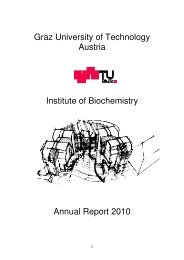Staff Members of the Institute of Biochemistry, TU - Institut für ...
Staff Members of the Institute of Biochemistry, TU - Institut für ...
Staff Members of the Institute of Biochemistry, TU - Institut für ...
You also want an ePaper? Increase the reach of your titles
YUMPU automatically turns print PDFs into web optimized ePapers that Google loves.
<strong>Biochemistry</strong> Group<br />
Group leader: Peter Macheroux<br />
Secretary: Annemarie Portschy<br />
Senior scientists: Alexandra Binter, Ines Waldner-Scott<br />
PhD students: Thomas Bergner, Bastian Daniel, Venugopal Gudipati, Tanja Knaus, Wolf-<br />
Dieter Lienhart, Silvia Wallner<br />
Master students: Corinna Dully, Karin Koch, Julia Koop, Katharina Lukas, Nicole Sudi,<br />
Marlene Tösch<br />
Technicians: Sabrina Moratti, Eva Maria Pointner, Steve Stipsits, Rosemarie Trenker-El-<br />
Toukhy<br />
General description<br />
The fundamental questions in <strong>the</strong> study <strong>of</strong> enzymes, <strong>the</strong> bio-catalysts <strong>of</strong> all living organisms,<br />
revolve around <strong>the</strong>ir ability to select a substrate (substrate specificity) and subject this<br />
substrate to a predetermined chemical reaction (reaction and regio-specificity). In general,<br />
only a few amino acid residues in <strong>the</strong> "active site" <strong>of</strong> an enzyme are involved in this process<br />
and hence provide <strong>the</strong> key to <strong>the</strong> processes taking place during enzyme catalysis. Therefore,<br />
<strong>the</strong> focus <strong>of</strong> our research is to achieve a deeper understanding <strong>of</strong> <strong>the</strong> functional role <strong>of</strong> amino<br />
acids in <strong>the</strong> active site <strong>of</strong> enzymes with regard to substrate-recognition and stereo- and<br />
regiospecificity <strong>of</strong> <strong>the</strong> chemical transformation. In addition, we are also interested in<br />
substrate-triggered conformational changes and how enzymes utilize c<strong>of</strong>actors (flavin,<br />
nicotinamide) to achieve catalysis. Towards <strong>the</strong>se aims we employ a multidisciplinary<br />
approach encompassing kinetic, <strong>the</strong>rmodynamic, spectroscopic and structural techniques. In<br />
addition, we use site-directed mutagenesis to generate mutant enzymes to probe <strong>the</strong>ir<br />
functional role in <strong>the</strong> mentioned processes. Fur<strong>the</strong>rmore, we collaborate with our partners in<br />
academia and industry to develop inhibitors for enzymes, which can yield important new<br />
insights into enzyme mechanisms and can be useful as potential lead compounds in <strong>the</strong> design<br />
<strong>of</strong> new drugs.<br />
The methods established in our laboratory comprise kinetic (stopped-flow and rapid quench<br />
analysis <strong>of</strong> enzymatic reactions), <strong>the</strong>rmodynamic (iso<strong>the</strong>rmal titration microcalorimetry) and<br />
spectroscopic (fluorescence, circular dichroism and UV/VIS absorbance) methods. We also<br />
frequently use MALDI-TOF and ESI mass spectrometry, protein purification techniques<br />
(chromatography and electrophoresis) and modern molecular biology methods to clone and<br />
express genes <strong>of</strong> interest. A brief description <strong>of</strong> our current research projects is given below.<br />
Berberine bridge enzyme & o<strong>the</strong>r flavin-dependent plant oxidases<br />
Berberine bridge enzyme (BBE) is a central enzyme in <strong>the</strong> biosyn<strong>the</strong>sis <strong>of</strong> berberine, a<br />
pharmaceutically important alkaloid. The enzyme possesses a covalently attached FAD<br />
moiety, which is essential for catalysis. The reaction involves <strong>the</strong> oxidation <strong>of</strong> <strong>the</strong> N-methyl<br />
group <strong>of</strong> <strong>the</strong> substrate (S)-reticuline by <strong>the</strong> enzyme-bound flavin and concomitant formation<br />
<strong>of</strong> a carbon-carbon bond (<strong>the</strong> “berberine bridge”). The ultimate acceptor <strong>of</strong> <strong>the</strong> substratederived<br />
electrons is dioxygen, which reoxidizes <strong>the</strong> flavin to its resting state:<br />
6














